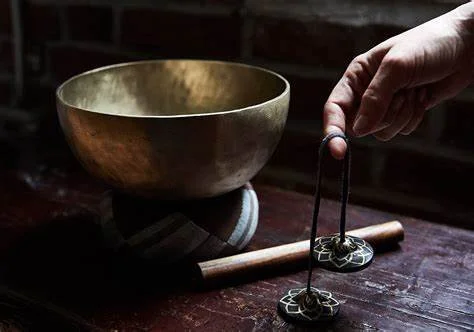
Breath & Meditation
“I have arrived. I am home. In the here and now, I am solid, I am free. In the ultimate I dwell.”
— Thich Nhat Hanh
Fridays at 6pm
Join Vinotha Raja as she shares her incredible gifts of teaching! This class includes pranayama and chanting mantras. Experience how breath and sound improve sleep quality, reduces high blood pressure, increases mindfulness and cognitive performance.
No prior experience needed, open to all.
Chanting Mantras with Vinotha
The purpose of meditation is for personal transformation, becoming a more conscious, peaceful and empowered human being. It is the experience of watching the functioning of your own mind in a calm manner so you can gain insight into your own behavior.
Join Joe Marquez one Sunday a month 4-5:15pm for a focus on the Inner Limbs of Yoga. Each class will use some movement to prepare for sitting. Monthly classes will introduce you to a pranayama or Kriya and offer both an instrumental and Insight Meditation. You can use your Punch Pass or a Drop-in for these sessions.
February 11 - Love & Forgiveness - Ho’Oponopono Prayer
Breath and Meditation
Rotating Schedule Restore @ 4!
Explore what 2024 could be like if we focused on restoration instead of optimization. Could this be the year we think about prioritizing recovery so that, over time, we can do more?
Embrace the idea that restoration is essential to growth. Protecting time to recover is a smart move, not a selfish one.
Plan ahead for 2024 dates:
2/4, 3/3, 4/7 - Roll, Release & Restore with Tim
2/11, 3/10, 4/14, - Breath & Meditation with Joe
1/21, 2/18, 3/17, 4/21, - Restorative Yoga & Nidra with Teresa
1/28, 2/25, 3/24, 4/28 - Surrender & Sound with Tim
Sunday Special Classes
Saturdays 4-5:30pm, January 20-February 10, 2024
This four-week series will introduce you to the Yogic approach to meditation and teach you its foundational principles to support you in creating a solid personal practice for yourself. You will be educated on the origins of this meditation according to Patanjali’s Eight Limb Path of Yoga, as well as the practical benefits and potential obstacles of a steady practice. Each class will include in-depth instruction for an experiential meditation, suggestions for creating a steady foundation for yourself at home, as well as time for answering any questions.
Introduction to Yoga Philosophy & Meditation
Sunday, January 28, 2024, 4-5:15pm
Join Timothy for this brand-new offering of Surrender and Sound supported by the power of affirmations. Open your body, mind and heart to experience the joyful essence that is your birthright! Timothy will guide you through a deeply relaxing Yin practice accompanied by the healing sound of singing bowls, followed by a guided affirmation practice. You are warmly invited to wake up to the joy that is the essence of your being!
$15 or use your class card
Surrender & Sound
Join Joe Marquez on Mondays at 7pm for Movement & Meditation. Joe will give you time following the Asana Practice for more experience with Pranayama (breath-work) Aum Chanting into Vipasana (insight Meditation)
This class supports inner clarity and focus.
”Yoga is not a work-out, it is a work-in. And this is the point of spiritual practice; to make us teachable; to open up our hearts and focus our awareness so that we can know what we already know and be who we already are.” — Rolf Gates
“Conscious breathing is the best antidote to stress, anxiety, and depression.”
— Amit Ray
Kapalabhati
Benefits and Impacts of this breathing technique (Kriya)
Heating & Energizing
Reduces mucus in sinus passages by its drying effect (supports Kapha imbalance)
Reverses the active and passive phases of a breath cycle and teaches a soft belly
Promotes upward rising energy in the head
Kapalabhati is used as a means for sensitizing the lower belly to various degrees of subtle activity and passivity. To embody the technique fully is to balance effort and surrender in a profound way.
During the course of a normal breath cycle, inhalation is always active: the external intercostal muscles lift and open the rib cage to begin the process of drawing oxygen into the lungs. The internal intercostals then pull the rib cage back to the starting position during the exhale, but they do this without muscular contraction, acting more like a spring that is automatically returning to its resting position after being stretched.
Kapalabhati inverts this process: the exhalation ensues as a result of subtle muscular contraction in the internal intercostals and the abdomen, and the inhalation happens passively as a result of a slight vacuum in the lungs that is created at the beginning of the exercise. Without the passive inhalation, the technique will not cultivate what is intended in this context: which is a new degree of sensitivity and skillful means in the lower regions of the abdomen.
“Without full awareness of breathing, there can be no development of meditative stability and understanding.”
— Thich Nhat Hanh
Nadi Shodhana
Benefits and Impacts of this breathing technique (Pranayama)
Balances the right and left energy channels (ida and pingala nadis)
Slows down and lengthens the inhale and the exhale
Promotes relaxation
The stimulation of the Nadis is associated with certain physical and mental characteristics. For instance, stimulating the left channel is said to be cooling, calming and orients the practitioner toward internalization. Stimulating the right channel is said to be heating, energizing and orients the practitioner toward external physical vitality.
The Sushumna nadi means she who is most gracious (Feuerstein, 1998, pg 352.) It is the central channel that moves upward along the cerebrospinal axis from the pelvic region to the crown of the head.
Nadi Shodhana Alternate Nostril Breathing
Nadi Shodhana: Using vishnu mudra, inhale through the left nostril, and exhale through the right nostril, then inhale through the right nostril, and exhale through the left nostril.
Chandra Bedhana: Inhale through the left nostril and exhale through the right nostril.
Surya Bedhana: Inhale through the right nostril and exhale through the left nostril.
Vishnu Mudra: The working hand that is used to close off one nostril at a time. The thumb and ring finger trace down the sides of the nose to where the bone and fleshy point meet. The two peace-sign fingers lightly press between the center brow (third eye).






